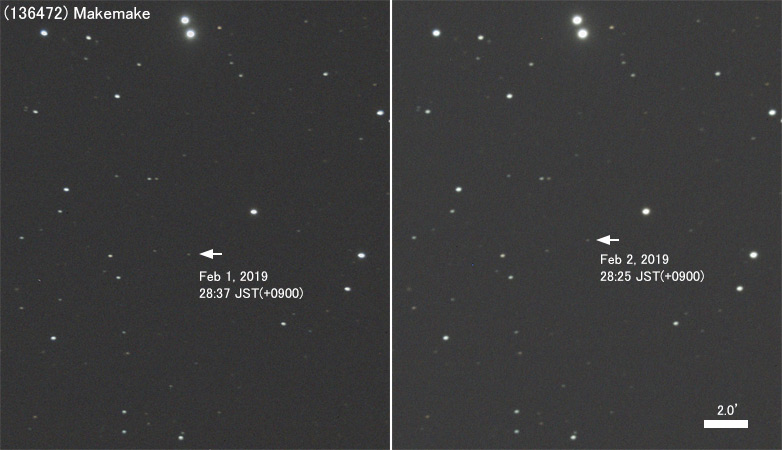| Date & Time: | Feb 1 2019, from 28:37 to 28:46 JST(+0900), 3min.×4shots |
| Feb 2 2019, from 28:22 to 28:28 JST(+0900), 3min.×3shots |
| Optical: | Meade 25cm(10") Schmidt-Cassegrain with conversion lens (f=1600mm, F6.3) |
| with BaaderPlanetarium Moon&Skyglow filter |
| Auto-guided with Meade LX200 Equatorial & Pictor 201XT |
| Digital Camera: | Canon EOS 6D (Remodeled) |
| Location: | Ooizumi, Hokuto city, Yamanashi pref. |
| (136472) Makemake |
|---|
| Semi-major axis | 45.354 au (6.785Bln km) |
|---|
| Perihelion distance | 37.948 au (5.677Bln km) |
|---|
| Aphelion distance | 52.762 au (7.893Bln km) |
|---|
| Orbital eccentricity | 0.163 |
|---|
| Orbital period | 305.45 yrs. |
|---|
| Parameters when photographed: |
| R.A. (2000.0) | 13h 07m 40.4s
→13h 07m 39.0s |
|---|
| Dec. (2000.0) | +23°50' 50"
→+23°51' 27" |
|---|
| Geocentric distance | 52.02 au (7.782Bln km) |
|---|
| Heliocentric distance | 52.54 au (7.860Bln km) |
|---|
| Magnitude | 16.9 |
|---|
Dwarf planet "Makemake" is one of Trans-Neptunian Objects (TNOs) classified in the Plutoid, discovered on Mar 31, 2005.
Makemake is revolving an elliptical orbit with a period of 305 years outside of the Pluto (247 years in period); the orbit tilts 29 degrees from the plane of the ecliptic.
A diameter of Makemake has been estimated as approximately 1400 km, about 60% of the Pluto.
The dwarf planet was named after God created the Easter island, registered as the third Plutoid next to the Pluto and the Eris in July 2008.
This image has displayed by turning the celestial north direction upward.
When I photographed, Makemake had a visual brightness of 16.9th magnitude and was moving toward NNW slowly in the central region of Coma Berenices.
Comparing two shots taken 24-hours apart, you can detect a Makemake's apparent movement of approximately 40 arc seconds.
|

